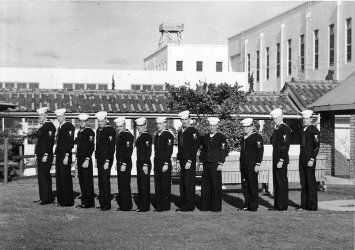
NSG Saitozaki, Kyushu 1963
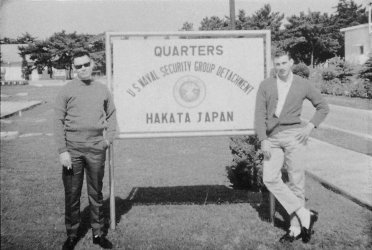
Fred Poteat - Jim Lawrence 1962/63
| Home | | | Back |
| NSG Detachment Hakata, Japan (circa 1962-1963) |
| Images from Jim Lawrence (former CTI2) |
| Please scroll-down. There are 7 photos. Click-on each photo to enlarge and read the page. A NEW BROWSER WINDOW WILL OPEN WHEN YOU CLICK-ON THE PHOTO(S) SHOWN BELOW. PLEASE CLOSE THAT NEW BROWSER WINDOW TO RETURN TO THIS MAIN WINDOW. |
 NSG Saitozaki, Kyushu 1963 |
 Fred Poteat - Jim Lawrence 1962/63 |
|
Above Left photo was the advancement photo for (August) 1962. (L-R) John Westerman, Joel Schiltz, Oscar Jeffers, Olin Bauman, Paul Rozewicz, David Cushing, Ed Lebrun, James Lawrence, Herbie Laflamme, Jerome Fuller, Robert L. Smith & Gary Luttjohann. Except for myself, they were all CTR branch, I was still officially CTI but only did linguist duty for one month while Jim Plum was on leave, halfway through my tour. I just made CTI2. I'm the fifth from the right. Directly in front of me is Ed Lebrun CTR2, two guys behind was Jerome "Jerry" Fuller CTR2. Behind him was a guy named Smith "Smitty" CTR1.
Above Right photo is of me and my buddy Freddy Poteet (from Panama City, FL) Freddy is on the left. I'm from Bucks County, PA. |
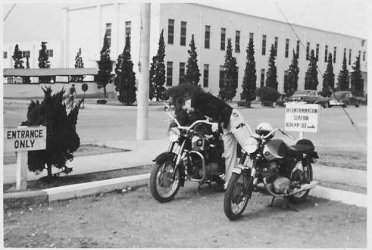 250cc Meguro |
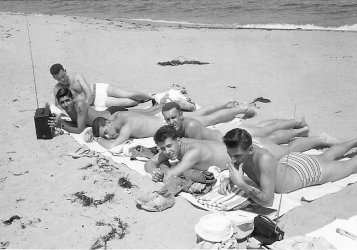 Saitozaki, Japan NSG Base Beach |
|
Above Left photo is of me and my 250 cc Meguro motorcycle taken in 63, with the Army barracks in the background. Navy personnel below E5 were assigned bunks there in the 1st floor right hand side. When I went back to Hakata in the 1990's it was the only building left standing on the entire base. There was a fence around it. I have a photo of that too someplace.
Above Right photo was taken on the Brady beach in the summer of 62. That's me far right with Tony Liott next to me, |
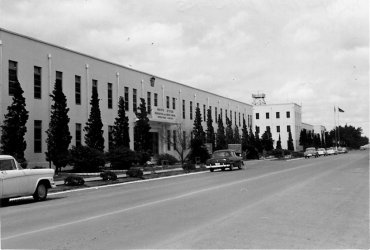 Army Barracks Brady AFB, Hakata, Japan 1962 |
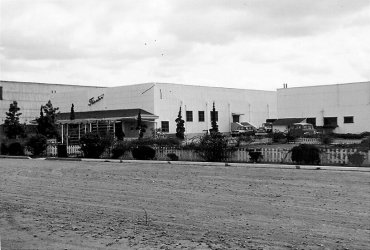 Brady AFB Theatre, Hakata, Japan 1962 |
|
Above Left photo Army barracks, again, Navy detachment bunked in the 1st floor right side of the building. This barracks face South, so the right side was the East side. Above Right photo is of Brady Air Base movie theater. It sat off to the right of the front of the Army barracks. |
 Brady AFB Post Office Far Left Hakata Bay 1962 |
|
Above photo is of the Brady Post Office sat at the far end of the street on the left. The road ended at Hakata Bay. Maybe someone can tell me what was in all those big buildings???
|
|
Some general information about Hakata/Brady Air Base. There were only 45 of us in the Navy Detachment including one officer, in my time Lt. Taylor, 2 chiefs, one in charge, first Harold Gunter, then Theodore Mara, and one who did decryption, then normally two or three first class who were section leaders, then a dozen or so second class and the rest almost all third class. Us grunts who manned the radios, 2nd class and below worked a rotating shift. Starting with an 8 hour Swing, 8 off, 8 hour Day, 8 off, 8 hour Grave, then 32 hours off, then start all over again. That made a seven day a week work schedule. I don't know about anyone else but in the 20 months I was at Hakata I didn't get one day of leave. The schedule was grueling to say the least. We always seemed tired, and we were always in a rush. By the time we hit the graveyard shift it was tough to stay awake but you had to keep alert because there was always someone to give you a hotfoot if you dozed off. I got my share... and gave one or two as well. E3s and E4s slept in the Army barracks in single bunks. You could have one or two small pieces of furniture next to your bunk. A chair and/or small table. I had a custom built stereo with a walnut cabinet and 2 large speaker systems in walnut. After you made E5 you were assigned to one of the Air Force bungalows that sat on the left side as you entered the base Main Gate. The Army barracks were further down the road on the right. The bungalows were sort of like condos with two of them attached in the middle and a front door at each end. There were two men assigned to each side. Separate single beds, not bunks, with end tables, dressers, chairs and a table, a closet each, and a regular bathroom with shower, sink and toilet. There wasn't a lot of extra room but you could still add whatever you liked. They were low squat buildings that sat in amongst some trees and were very cozy. Jerry Fuller and I shared a bungalow and we each kept a bottle of Brandy in our night stand for a nightcap if we wanted. I don't remember anyone ever entering our quarters without an invitation, so the privacy was nice too after living in barracks your entire military life up to that point. After making 2nd class you also had the option of receiving subsistance pay instead of just eating all three meals everyday at the Army chow hall. You could still eat there, but you had to pay each time. Liberty consisted of what you could do in 32 hours, that is after you got about 10 hours sleep off your graveyard shift. That meant you'd wake up in the late afternoon, go get dinner at the chow hall, hang around for an hour or so telling lies to all your friends, then either going to the base movie, the EM (enlisted men's) Club on base, or going into either Saitozaki to down a few drinks, mostly beer, and the logical consequence of that, or head over into the bright lights of Fukuoka for some entertainment or local culture. The Yatai (mobile food stands) along the river were always interesting, a really nice German style rooftop beer hall, clubs, restaurants, a floor show, department stores, tailor shops, jewelry stores, markets, so much to do there. If you had a Japanese girl friend, which was actually against regulations for us because of our security clearances, there were temples and shrines, beaches and mountains to go exploring in as well. My wife Kimiko and I used to go to Fukuoka regularly where I would soak up Japanese culture and language like a sponge. Dazaifu was about the most distant place we ever went, a trip we made again when we were last in Kyushu in the late 90's. The EM Club was a really nice place to socialize. Drinks were cheap and varied, there was a jukebox and once a week? some of the guys who had musical talent would get a band together and play on the small stage. We had Hiram Pritchard from Texas who played saxophone, Jim Plum from Iowa played drums, and several others played guitars, piano, bass and trumpet. Once a week or month, we had a woman from a jewelry store, and a tailor, both from Fukuoka, who would bring samples with them to sell items to us. I bought lots of shirts, vests, suits and a couple beautiful coats from Hong Kong Tailors, and a really nice Blue Sapphire ring from the jeweler. I gave the clothing away as I grew out of them, but still have the ring. As time went by during your tour at the base, alternative transportation might become something you would address. You could walk down into Saitozaki, and if a bit too woozy on the way back, take a cab. You could also take a bus into Fukuoka and again, a cab back if it was late or your sense of direction was blurred. Cabs, even when shared, got expensive after a time and there were options. I chose to go into Fukuoka to a motorcycle dealer and bought a used Meguro. It had a one cylinder 250 cc engine. At the time the Japanese motorcycle police rode two cylinder 500 cc Meguros. So I couldn't outrun the police I suppose. Others bought mostly Hondas, 125s or 250s. Bob Killen bought a British Triumph 500 cc Other options were usually bicycles, or cars, especially those that had been brought over from the U.S. by those who went before and then sold their car to someone before they left to go back to the U.S. So a wide variety of recent and very unrecent vehicles came on the market sporadically. I think we had to get base license plates for them, but I don't remember any inspections or insurance requirements, nor driver's tests, utilizing our home state driver's licenses for the duration of our tour. One thing to remember is that in Japan you drive on the left, so American cars had an inherent danger involved in driving them in Japan. Our base Army PX wasn't all that big but fairly well stocked with items young men would crave. The normal array of toiletries and clothing, but I remember most the new releases on 45's and music albums from the U.S. I also remember the Japanese craft items sold there. Hakata dolls, fans, china, especially sets of Noritake, bamboo and beautifully crafted wooden items that all sold at prices you'd never see off base. Which brings me to U.S. script. Funny money printed by the U.S. government, I suppose to keep American dollars out of the hands of the Japanese. I sure missed greenbacks when I was in Japan. We could buy Yen with script at 360 Yen to the dollar. We needed that disparity in order to survive on $65. a month even if we didn't have enough free time to really enjoy it. I truly loved Japan, even though I couldn't wait to go back to the U.S. at the time. The grueling work schedule had more to do with it than anything else. Kimiko and I made dozens of trips back to Japan over the years, staying with relatives mostly up until seven years ago when we finally rented an apartment near her relatives to stay at when we went over, and then four years ago we bought a cute little house a few miles away that we go to once a year now, staying 3 to 6 months at a time. We have a small car there and a 250cc Honda scooter that we tool around on in nice weather. I still love most aspects of Japanese life and never get tired of the things we see and do there. We've also surrounded ourselves here in the U.S. with Japanese art and objects that we take pleasure in on a daily basis. And finally, Kimiko's many, many years as a professional chef in Japanese restaurants lends itself well to my love of quality Japanese food. |
| Home | | | Back |